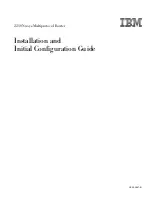
Overview
661
dropped and the other traffic is permitted. The Ethernet switch adopts a
complicated traffic classification rule to filter the packets based on much
information and to drop these useless, unreliable, and doubtful packets.
Therefore, the network security is enhanced.
The two critical steps in the packet filter operation are:
Step1: Classify the inbound packets to the port by the set classification rule.
Step 2: Perform the filter--drop operation on the classified packets.
The packet filter function can be implemented by applying ACL rules on the port.
Refer to the description in t“ACL Configuration” on page 637 for detailed
configurations.
Rate Limit on Ports
Rate limit on ports is port-based rate limit. It limits the total rate of outbound
packets on a port.
TP
The network will be made more congested by plenty of continuous burst packets
if the traffic of each user is not limited. The traffic of each user must be limited in
order to make better use of the limited network resources and provide better
service for more users. For example, the traffic can only get its committed
resources in an interval to avoid network congestion caused by excess bursts.
TP (traffic policing) is a kind of traffic control policy to limit the traffic and its
resource usage by supervising the traffic specification. The regulation policy is
implemented according to the evaluation result on the premise of knowing
whether the traffic exceeds the specification when TP or TS is performed. The
token bucket is generally adopted in the evaluation of traffic specification.
Traffic evaluation and the token bucket
The token bucket can be considered as a container with a certain capacity to hold
tokens. The system puts tokens into the bucket at the set rate. When the token
bucket is full, the extra tokens will overflow and the number of tokens in the
bucket stops increasing.
Summary of Contents for Switch 7754
Page 32: ...32 CHAPTER 1 CLI OVERVIEW ...
Page 70: ...70 CHAPTER 5 LOGGING IN USING MODEM ...
Page 76: ...76 CHAPTER 7 LOGGING IN THROUGH NMS ...
Page 86: ...86 CHAPTER 9 CONFIGURATION FILE MANAGEMENT ...
Page 120: ...120 CHAPTER 13 ISOLATE USER VLAN CONFIGURATION ...
Page 126: ...126 CHAPTER 14 SUPER VLAN ...
Page 136: ...136 CHAPTER 16 IP PERFORMANCE CONFIGURATION ...
Page 152: ...152 CHAPTER 17 IPX CONFIGURATION ...
Page 164: ...164 CHAPTER 19 QINQ CONFIGURATION ...
Page 172: ...172 CHAPTER 21 SHARED VLAN CONFIGURATION ...
Page 182: ...182 CHAPTER 22 PORT BASIC CONFIGURATION ...
Page 198: ...198 CHAPTER 24 PORT ISOLATION CONFIGURATION ...
Page 208: ...208 CHAPTER 25 PORT SECURITY CONFIGURATION ...
Page 224: ...224 CHAPTER 27 DLDP CONFIGURATION ...
Page 232: ...232 CHAPTER 28 MAC ADDRESS TABLE MANAGEMENT ...
Page 240: ...240 CHAPTER 29 CENTRALIZED MAC ADDRESS AUTHENTICATION CONFIGURATION ...
Page 280: ...280 CHAPTER 30 MSTP CONFIGURATION ...
Page 348: ...348 CHAPTER 35 IS IS CONFIGURATION ...
Page 408: ...408 CHAPTER 39 802 1X CONFIGURATION ...
Page 412: ...412 CHAPTER 40 HABP CONFIGURATION ...
Page 422: ...422 CHAPTER 41 MULTICAST OVERVIEW ...
Page 426: ...426 CHAPTER 42 GMRP CONFIGURATION ...
Page 480: ...480 CHAPTER 47 PIM CONFIGURATION ...
Page 506: ...506 CHAPTER 48 MSDP CONFIGURATION ...
Page 552: ...552 CHAPTER 51 TRAFFIC ACCOUNTING CONFIGURATION ...
Page 570: ...570 CHAPTER 53 HA CONFIGURATION ...
Page 582: ...582 CHAPTER 54 ARP CONFIGURATION SwitchA arp protective down recover interval 200 ...
Page 622: ...622 CHAPTER 58 DHCP RELAY AGENT CONFIGURATION ...
Page 684: ...684 CHAPTER 61 QOS CONFIGURATION ...
Page 718: ...718 CHAPTER 63 CLUSTER ...
Page 738: ...738 CHAPTER 67 UDP HELPER CONFIGURATION ...
Page 752: ...752 CHAPTER 69 RMON CONFIGURATION ...
Page 772: ...772 CHAPTER 70 NTP CONFIGURATION ...
Page 796: ...796 CHAPTER 72 FILE SYSTEM MANAGEMENT ...
Page 802: ...802 CHAPTER 73 BIMS CONFIGURATION ...
Page 814: ...814 CHAPTER 74 FTP AND TFTP CONFIGURATION ...
Page 830: ...830 CHAPTER 75 INFORMATION CENTER ...
Page 836: ...836 CHAPTER 76 DNS CONFIGURATION ...
Page 852: ...852 CHAPTER 77 BOOTROM AND HOST SOFTWARE LOADING ...
Page 858: ...858 CHAPTER 78 BASIC SYSTEM CONFIGURATION DEBUGGING ...
















































